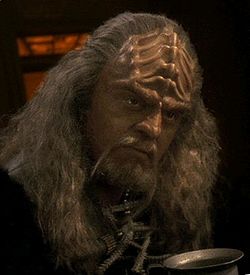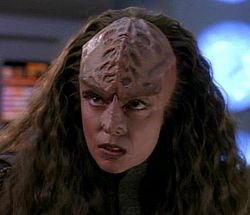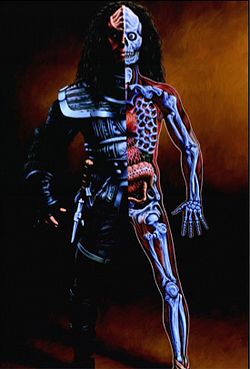Klingon
From Starfleet Commander
Revision as of 20:09, 19 December 2015 by Gary Mintz (talk | contribs)
History
- The Klingons (Klingonese: tlhIngan) are a humanoid warrior species that originated from the planet Qo'noS (pronounced Kronos), an M-class planet. One of the major powers of the galaxy, the Klingons are a proud, tradition-bound people who valued honor and combat. The aggressive Klingon culture had made them an interstellar military power to be respected and feared. Klingons believed that they had the instinctive ability to look an opponent in the eye and see any intent to kill.
Biology
- The Klingon race are humanoids that stand on average at 1.6 to 1.9 meters in height and tend to have a skin tone that ranges from a swarthy olive to brown. Their hair is usually braided or worn loose and is black or dark brown in color, although it turns gray or white with age. The most distinctive feature of the Klingon species are their forehead ridges which are typically unique to each individual, although family members may share similar ridge features. While externally somewhat similar to Human's, Klingons are larger and stronger than typical human's but have a much reduced tolerance of cold temperatures.
- Internally, they possess eight-chambered heart's, two liver's, multiple stomach's, and an astounding twenty-three rib pairs. This is known to the Klingons as brak'lul. In the field of battle these redundancies allow warrior's to continue to fight even after sustaining significant injuries. Klingon physiology also included a symmetrical organ called the QiVon. For Klingons, arsenic was a necessary part of the Klingon diet instead of the deadly poison that it was to human's. Arsenic deficiency could in fact lead to a number of health problem's for Klingons.
- In their history the Klingons experimented with genetic modification to further enhance themselves on several occasions, this resulted in several distinct groups of Klingons, most notably the QuchHa', meaning "unhappy ones" which were created in the 22nd century and represented a significant proportion of the Klingon population until the late 23rd century.
- Other genetically modified variants of the species included the Chalchaj 'qmey and the M'tachtar.
Military
- The Klingon Empire is a warrior culture and embraces these attributes. The role of expansion and defense are both prided and conducted by the Klingon Defense Force. While the agency controls the starships that bring new worlds into the empire, it is the Planetary Regiments that conquer the world itself and secure it in the name of the Empire. The upper levels of the Defense Force consists of the Klingon High Command.
- There appears to be an elite academy group consisting of young warriors known as the First Cadre which seems as the Empire's equivalent of Starfleet's Omega Squad.
- A prestigious award known as the Star of Kahless is awarded to those inducted into the Order of Kahless.
- Being a warrior culture, the Klingons developed several combat tactics to use in battle one of which is the N'yengoran strategy which details ways of attacking fortified ground based enemy positions. One such military tactic is the BIng maneuver. It was also known that much of the Klingon Empire's scientific breakthroughs were made by the subjugation of advanced technological societies.
Culture
- Klingon culture was shaped by centuries of tradition. Most of the basics of their society were laid out by
Kahless the Unforgettable during the forging of the First Empire.
- The Code of Kahless consisted of basic rules to limit combat to a contest between equals. It ensured Klingons remained true to their word, that they would not intentionally target non-combatants, or declared neutral parties, and that they would attack openly, and not hide behind poisons or assassins. It also ensured that Klingon warriors would fight for their families and houses, not just for themselves, providing the foundations for a stable Klingon civilization. While for periods of Klingon history the Code had been distorted, or largely ignored, it had never been entirely forgotten, and ensured at least some semblance of Klingon unity.
Beliefs
- According to Klingon belief, the honored dead serve with Kahless the Unforgettable in Sto-Vo-Kor, where, according to some tradition, they serve in the Black Fleet, battling one another in a constant cycle of glorious battle, interspersed with great feasts and the singing of songs and tales of battle.
- The dishonored, however, are banished forever to the fire and icy wastes of Gre'thor, a barren wasteland guarded by the great Fek'lhr beast, the Klingon devil. When a dishonored Klingon died, they would not appear in Gre'thor at once but would have to make the journey to this darker aspect of the afterlife. Once a Klingon arrived in the underworld, they would board the Barge of the Dead, where Kortar, the first Klingon, would set sail for Gre'thor. On the journey there are many dangers, such as the Kos'karii, who attempt to lure warrior's into the water with their siren-like voices so that they would be lost forever.
Family
- Klingon marriage ceremonies were designed to emulate the original marriage made between Kahless and the Lady Lukara, and the myth of the first marriage in Klingon society of Kortar who mated with the first Klingon woman and destroyed the gods that created them. In the ceremony, the groom would be accompanied by the Tawi'Yan, the sword bearer, who's function was similar to that of the best man in Human weddings. These individuals carried fake clubs to represent the soldiers of the tyrant Molor who came to kill Kahless and the Lady Lukara moments after they were married.
Behavior
- The Klingon species are highly aggressive and are known to fight for almost any reason but typically do so when honor is at stake. Due to their nature as predators, any form of suspicious behavior from whispering to weakness can set off their warrior instincts. Conflicts such as insults to their honor, injustice, a difference in opinion or a crime can only be resolved through violence. As such, Klingons do not shirk from combat and backing away from such confrontations is seen as a sign of cowardice.
- The race's warrior mind set means that they prefer matters to be clear-cut with speech as well as manners being blunt - this means that they ignore ambiguous concepts as there should be no misunderstanding. To the Klingon psyche, things are either black or white, good or evil - there is nothing in-between the two. This means that a warrior must declare his intent and say what's on his mind. They do this proudly and look into the eyes of others as not doing so is insulting.
- Klingon culture was shaped around the following of the K'ajii, the Warrior Path. This means that every Klingon wants to grow up to be a warrior which has resulted in the prominence of the warrior caste. However, with so many recruits there exists few positions to fill the demand as every individual seeks to gain entry into the best Klingon academy. At graduation, the Klingon petitions his house for warrior status which is a prideful act. However, those that do not reach such positions within their lives are expected to find other means to support themselves as well as their houses through some other lower profession such as being a factory worker, farmer or a merchant.
- Klingon culture is often brutal and extremely violent. Duels to the death over trivial insults were common place, and vendettas between various Klingon families could often result in virtual all-out war. In combat, the Klingons are unyielding, refusing to withdraw or retreat even against unwinable odds. Surrender is not an option for a Klingon warrior.
- Klingons enjoyed life to the full, each victory in battle was celebrated with great feasts, and even defeats are celebrated in songs and stories. The experience of battle was often as important as a victory.
- The loyalties of Klingons were generally first to their family, then to their house, and finally to the Empire. When the goals of the High Council and the goals of their house were in conflict, Klingons would invariably support their family and close allies over their government.
Rituals
- Klingon culture is defined by and full of ritual, these include: The Age of Inclusion, Ak'voh, Brek'tal ritual, Bre'Nan ritual, Day of Honor, Challenge of Spirit, Discommendation, Hegh'bat, Ja'chuq, Kal'Hyah, Kot'baval festival, Mauk-to'Vor, Muar'tek Festival, Plea for the Dead, Rite of Ascension, Rite of Blood Peace, Rite of MajQa, Rite of Succession, Rite of Vengeance, R'uustai, Sonchi ceremony, SonchIy ceremony and Ya'nora kor.
Recreation
- Klingon recreational activities include the B'aht Qul challenge, Baqlaq and Qa'vak.
Foods and drink
- Klingon cuisine included: mot'loch, chechtlhutlh, heart of targ, persaba fruit, rokeg blood pie, bregit lung, sour tea, khizr, Qagh, krada legs, minn'hor cheese, durani lizard skins, warnog, bahgol, gagh, racht, zilm'kach fruit, pipius claw, grapok sauce, gladst, whitefang steak.
- Klingon drinks included: boiling worm wine, raktajino, bloodwine and firewine.
- While human's could consume some Klingon foods safely, there were other dishes that were not safe for humans to consume. Consumption of those dishes could lead to illness or death for human's. Some Klingon dishes contained arsenic, which was poisonous for humans but a necessary part of the Klingon diet.
Excepts from Memory-beta Klingon also see Memory-alpha Klingon for more information.


